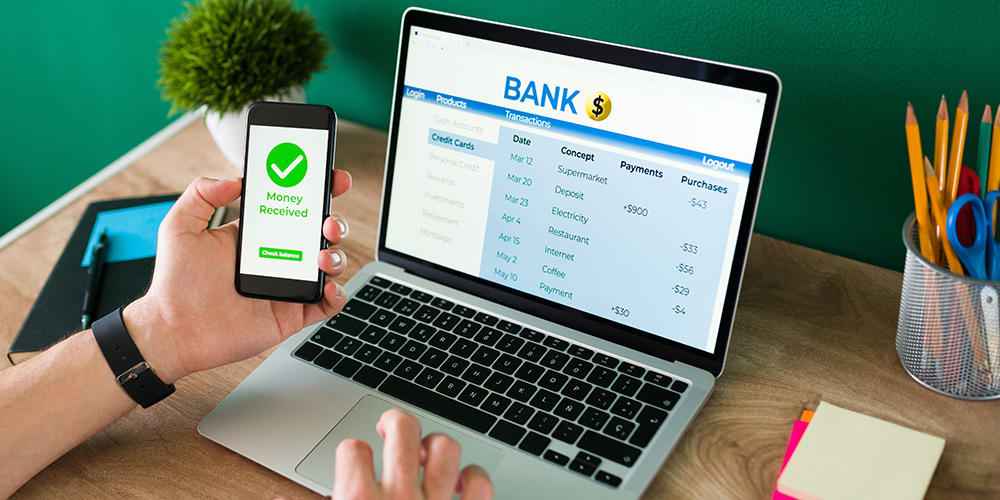What is the Automated Clearing House (ACH) and How Does it Affect Your Loan?

The first iteration of the Automated Clearing House (ACH) was introduced in California in 1972. It was intended to be a solution to the increasingly longer clearance times for paper checks.
Other regional versions of ACH appeared soon after the California entity was formed. That led to the establishment of the National Automated Clearing House Association (NACHA) in 1974. NACHA sets and enforces the rules for ACH. The Federal Reserve Bank and the Electronic Payments Network handle the operation of the network.
The foresight of the California banks that formed the ACH helped lay the foundation for the electronic banking system we’re accustomed to today. It’s also available in other countries, but U.S. banks typically use the SWIFT network for international transfers. That’s a topic for another day.
How does an automated Clearing House (ACH) bank transfer work?
ACH bank transfers could be described as “digital checks.” They’re an electronic transfer of funds from one bank account to another. Lenders can initiate an ACH transfer when they approve a loan application. Borrowers can agree to have repayments debited by ACH instead of writing checks. We’ll get into that in more detail below.
Sending a money transfer with the Automated Clearing House is done using “routing numbers” and “account numbers.” The routing number is a nine-digit number that identifies the bank. The account number is unique to the individual. ACH payments are drawn using the same system. Money is debited from one account and sent to another.
The system seems simple with the technology we have available today. According to NACHA, over thirty billion ACH payments are sent yearly, totaling nearly $80 trillion, but that number could increase if banks raise their maximum ACH transfer limits. NACHA’s current ACH daily limit is $1 million. Most banks allow significantly less than that.
Examples of ACH transactions
An ACH loan is an example of an ACH transaction. It’s common with online lenders and digital banks that offer a virtual lending experience. The loan applicant submits their information through an online portal, and the lender transfers funds via ACH when the application is approved. No physical paperwork is required.
Other common examples of ACH transactions are direct deposits of tax returns, social security benefit payments, and paychecks. The sender in each of these situations, like the lender in an ACH loan scenario, must request authorization from the recipient to send the money. Those who get their paychecks directly deposited are familiar with this.
Important Note: An ACH payment is not the same as a “wire transfer.” The automated clearing house could take several days to process a payment. Wire transfers typically happen within the same day. They’re also more expensive. The price disparity makes ACH a more popular option.
How to apply for and manage an ACH loan
Applying for an ACH loan is typically done through an online portal, but some banks and credit unions still have a paper application option. What separates an ACH loan from other types of loans is that the funds are transferred from the lender to the borrower via ACH. In return, the borrower is usually required to set up ACH repayments.
Convenience and speed are two of the advantages of using the Automated Clearing House system to borrow and pay back money. Those elements can also disrupt the borrower’s finances if they are not managed correctly. ACH payments come out automatically when they’re due. The borrower needs to make sure that funds are there to cover them.
What information is needed for ACH payment?
Some lenders may ask for a digital copy of a state driver’s license or ID when you apply for an ACH loan. The lender will also ask for the borrower’s routing number and account number to deposit funds. For repayment, they may require a signature on an agreement to do ACH debits. These three elements are consistent with most ACH loans.
Some lenders require more. Loan applicants should be prepared to provide bank statements and proof of employment. Lenders also check credit scores. If they do a “hard inquiry,” that check may temporarily cause the applicant’s credit score to go down. The score will go back up again when the borrower starts to make payments on their loan.
Keep in mind, federal law prohibits lenders from conditioning personal loans on obtaining authorization from consumers for preauthorized (or recurring) electronic fund transfers. For those who do not wish to provide the personal information necessary for ACH transactions, there are other loan repayment options. Paper checks are still accepted by many lenders. Credit cards may also be an option for loan repayments. The lender should provide a list of payment options before the final loan agreement is signed.
The pros of ACH payments
There are several reasons why the ACH system is preferred over traditional checks or credit cards for payments. There are also some drawbacks. Here are the pros:
- Convenience: The Automated Clearing House eliminates the need to process paper checks or physically go to the bank. ACH transactions are electronic and can be initiated online at a local bank, credit union, online lender, or vendor/creditor.
- Accuracy: Handwritten documents (like checks) can be difficult to read. ACH requests are typed, so there’s no dispute over how much money is being sent and where it’s going. The routing and account numbers provide an exact digital address.
- Cost: NACHA estimates that the costs of ACH transactions are a fraction of check costs. They estimate the median costs of initiating and receiving an ACH payment to be between 26 cents and 50 cents.
- Security: If the routing and account numbers are entered correctly and by the proper party, ACH is one of the most secure ways to transfer money.
The cons of ACH payments
- U.S. Only: ACH is available in other countries, but U.S. banks rarely use it for international transfers. Most banks use the SWIFT network for those. 89% of SWIFT’s cross-border transactions are processed within an hour.
- Processing Times: Wire transfers are more expensive because they can be processed on the same day they’re sent. ACH payments historically have taken several days, but that’s changing as banking technology improves.
- Amount Limits: NACHA allows up to $1 million per day in ACH transactions, but most banking institutions have daily limits of $25,000 or less. This is another “con” that is likely to change in the next few years, but it’s still an obstacle today.
- Potential Fraud: The ACH system can be used for fraudulent transactions if someone provides the wrong routing and account numbers. This has led to payroll fraud in some instances. NACHA has added new security protocols in an effort to prevent that.
How to stop ACH debits or payments
Once authorized, ACH debits will come out of your bank account as scheduled. Stopping those debits may be difficult, especially if your ACH loan came from a payday lender. Your ACH authorization should clearly state how the ACH can be stopped or revoked. If you wish to stop an ACH, contact the lender to make other payment arrangements. If that doesn’t work, call your bank, and request a “stop payment” on future debits.
The best way to avoid this scenario is to carefully review your budget before taking out an ACH loan. You’ll also want to carefully investigate the lender. Agreeing to the high-interest rates and fees some lenders require will often backfire if you can’t afford your payments. To avoid this, evaluate your financial situation, the lender, and the loan to determine if it’s right for you.
Please note the below article contains links to external sites outside of OppU and Opportunity Financial, LLC. These sources, while vetted, are not affiliated with OppU. If you click on any of the links you will be sent to an external site with different terms and conditions that may differ from OppU’s policies. We recommend you do your own research before engaging in any products or services listed below. OppU is not a subject matter expert, nor does it assume responsibility if you decide to engage with any of these products or services.

